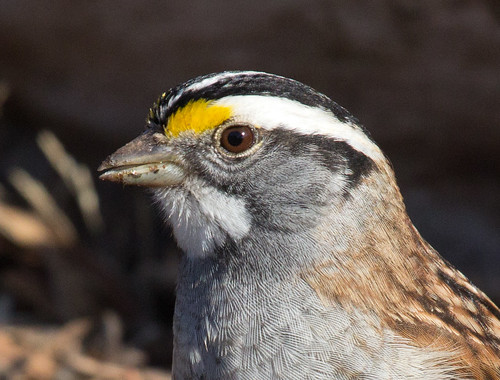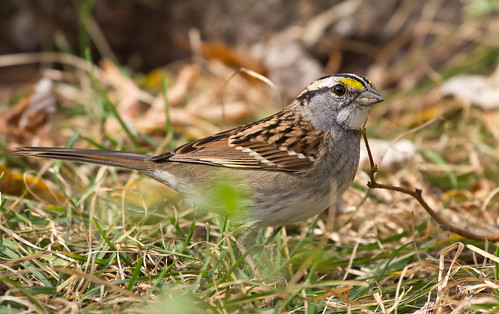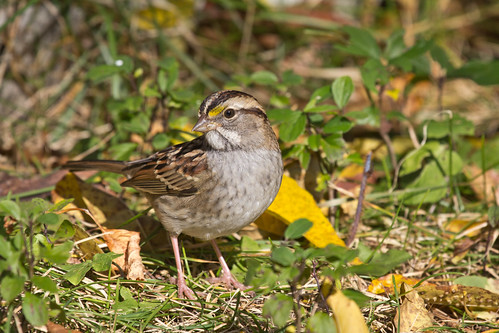 |
The White-throated Sparrow is one of my all-time favorite birds. I saw and heard my first on April 12, 1975, when I was a brand-new birder. I was in Virginia for an environmental education conference right when White-throats were in full migration down there. Within a week or so, they were up in Michigan where I was living, and nestled into a permanent place deep in my heart.
White-throated Sparrows are unique in the bird world—indeed, in the entire vertebrate world as far as we know right now—for a bizarre genetic condition. At some point long, long ago, in some individuals, a large section of their Chromosome 2, involving more than 1,100 genes, mutated, becoming inverted. The inversion meant that during reproduction, that section of chromosome had no match with a normal Chromosome 2, which led to even more mutations and inversions within that inverted section of the chromosome. Yet somehow those individuals with the mutation survived and reproduced.
Of the thousands of White-throated Sparrows whose chromosomes were examined, not one had two copies of the inverted Chromosome 2s. Just about exactly half had two non-inverted Chromosome 2s, and half had one inverted and one non-inverted Chromosome 2. In other words, Chromosome 2 was behaving exactly as vertebrate sex chromosomes do.
About half of all mammals have one X and one Y chromosome (these are the males), about half have two Xs (the females), and about zero have two Ys. To produce young, one individual mammal with two Xs (a female) and one with an X and a Y (a male) are needed. Birds, snakes, and butterflies have a slightly different system. Their sex chromosomes are named W and Z, and it’s the females with the two different chromosomes—females are WZ. Males are the ones with the identical sex chromosome: ZZ. None of these animals ever have two W chromosomes.
Some of the genes on the inverted section of the White-throated Sparrow’s Chromosome 2 are involved in courtship, mating, and breeding behaviors. Chromosome 2 also determines each bird’s appearance. Those with an inverted and a non-inverted Chromosome 2 have white head stripes, are promiscuous, provide poor parental care, are highly aggressive, and have a very musical song. Those with two non-inverted Chromosome 2s have tan head stripes, are very monogamous, provide good parental care, are very protective and nurturing, and have a far less tuneful song.
 |
| This white-striped White-throated Sparrow has one inverted and one non-inverted Chromosome 2 |
 |
| This tan-striped White-throated Sparrow has two non-inverted Chromosome 2s. |
White-throated Sparrows have the W and Z sex chromosomes as well as the inverted or non-inverted Chromosome 2. And intriguingly and uniquely, all reproductive pairings involve two different sets of opposites: virtually every mated pair has a male and a female, of course, but also, each pair has one tan-striped and one white-striped individual.
The scientist who led the research that teased out all of this, Elaina Tuttle, did field and laboratory work on this one species for over 25 years. (Read an excellent article about her seminal research in the current issue of Nature.) So much painstaking research on a single species is almost unheard of today.
Dr. Tuttle grew fascinated with the species while she was researching fish ecology in New York’s Finger Lakes—White-throated Sparrows fill the woods of Upstate New York with song from spring through summer. It was already well known that the behaviors of the white- and tan-striped birds are quite different, and that pairs virtually always include one of each, and she became obsessed with the question of why. A paper from 1966 described the weirdly inverted Chromosome 2, and how just about exactly half of all males and half of all females had one inverted version and half had zero inverted versions, suggesting that there had to be some mechanism that caused birds to always select the opposite of what they were. But how this worked was not understood until Dr. Tuttle began her work. She met Rusty Gonser in 1991. Their similar research interests evolved, and they married in 1994. The two of them worked together on the puzzle ever since, publishing the culmination of this work this January in Current Biology, just a few months before her tragic death from breast cancer on June 15.
No one knows how sustainable it is for any species to maintain the complex mating system White-throated Sparrows have, in which birds can only select from 25% of a population, rather than 50%, for a suitable mate. It's possible similar systems have evolved and died out in the past. And no one knows what genetic and environmental factors led to White-throated Sparrows evolving this system in the first place, rather than causing birds with the inversion mutation to simply die out. Dr. Gonser intends to continue the research he and his wife have done together for so many years, hoping to reveal even more secrets involving this satisfyingly mysterious yet common little bird.